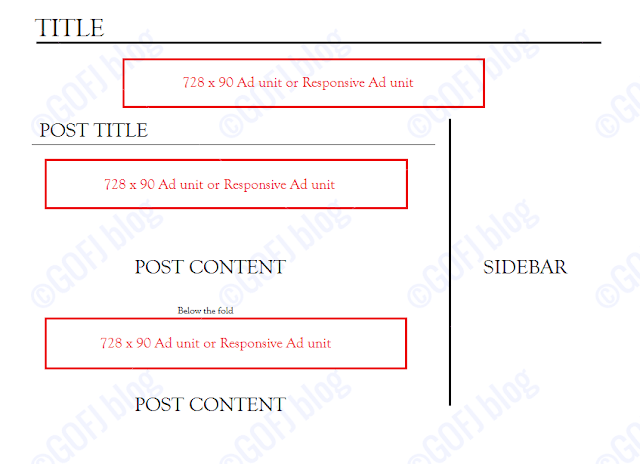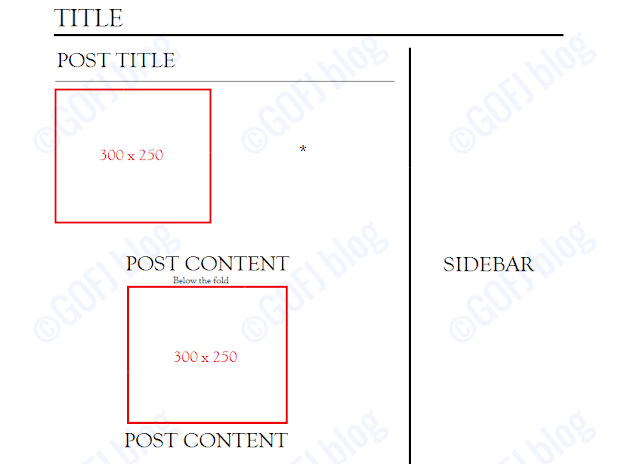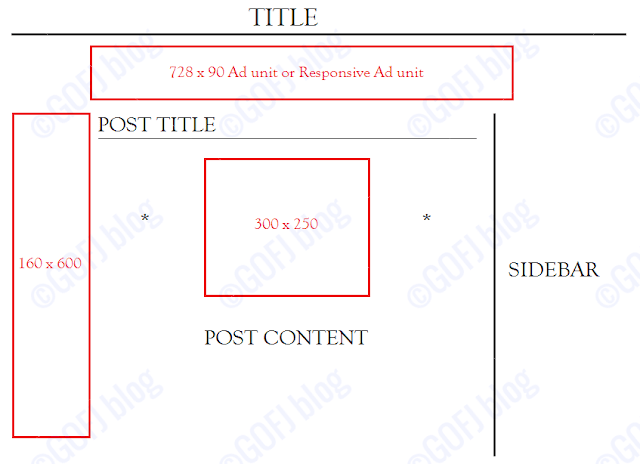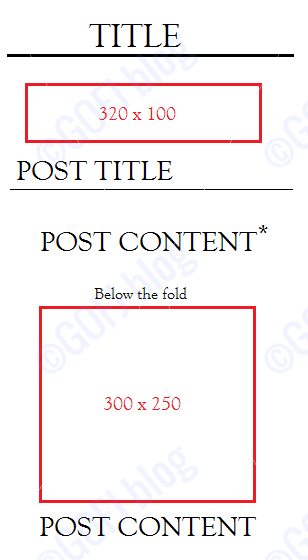While Google Adsense is the best pay per click advertising network in the world, it might not perform well if we place the ad units in wrong ad spaces. We should implement properly the ads on the site to increase the Click Through Rate, which will eventually increase the overall earnings. Most of the publishers earn a tiny amount of money because of incorrect ad placements and using uncommon ad units.
By placing ads of the correct size on the right ad space(s) one can earn more than the current performance. I’m an Adsense publisher and I’ve tested different ad sizes & its placement many times to improve the earnings. At last, I found some of the best ad spaces on my site(s) which increased my earnings by up to 300% more than what I earned at the beginning with the same traffic. I will share my experience with Google Adsense ad size selection and ad placement, adding the tips for Adsense ad placement that may help you improve your Google Adsense earnings.

Few Points I’d like to add before I Start:
- I’ve few blogs and to say the truth, same ad placements on those blogs never worked well. What I learned is each blog needed separate optimization according to the blog design, layout, and its niche.
- So, I advise you not to follow my Google Adsense optimization guidelines or other’s guide exactly as it is. You must perform A/B testing to find the best performing ad spots on your site.
- Read this article only to get some ideas about the best ad placement for maximum CTR. This article might or might not improve your Google Adsense earnings.
Related article – How to sell direct banner ads.
Tips for Adsense Ad Placement
About best-performing Ad sizes:
- Google Adsense has advised in their guide that publishers should make use of the most successful ad units most to improve the Adsense earnings and user experience of the blog. These are the few ad units that I found performed best on my blog(s).
- 728 x 90 leaderboard Adsense unit is one of the best-performing ad units when it is placed in the right spot. This ad unit received low to average CTR based on the niche. But, the CPC was higher compared to other Adsense ad units.
- 300 x 250 and 336 x 280 rectangle ad units were equally good in the performance, like the 728 x 90 ad units. These ad units received high CTR and CPC was good too.
- 320 x 100 mobile ad unit placed above the post title performed well compared to other ad units. CTR was low, but CPC was higher compared to other ad units placed on the mobile page.
- Few say placing text link ad units can affect user experience and earnings. What I found was few effectively placed link ad units performed well compared to regular banner ad units.
Warnings on Google Adsense Ads Placements:
- Google Adsense has introduced a new policy regarding ads limit per page policy. Now the publishers can place as many ads they wish, provided there should be enough content to match the number of ads. If you’re unclear about this policy, this guide will help you – Adsense ads limit per page.
- Never place large ad units above the fold on mobile phone optimized pages. Placing large ad units such as 300 x 250 above the fold is considered the policy violation.
- Previously, placing more than one large ad unit (ex. 300 x 600) on a page was considered the policy violation. But now publishers may place more than one large Adsense ad unit. But placing more than one large unit will affect user experience and performance of the blog.
Factors that affect RPM which depend on CTR and CPC:
- CPC is the cost per click and CTR is the click-through rate. They both play the key role in determining RPM. If anyone of these gets low or high, it will affect RPM.
- In simple, if a blog generates 2% CTR with an average CPC of $0.20, the RPM will be $4. At the same time, if it generates 4% CTR with an average CPC of $0.10, the RPM will be the same $4. So, fluctuation in any of these will reduce RPM. You must concentrate on increasing both CTR and CPC to increase the RPM.
- The main reason for low CPC is the niche of the blog. Other reasons for low CPC are using non-successful ad units, ad placements, less viewability, using too many ads on a page, etc.
- The main reason for low CTR is poor ad placement & site layout. Other reasons for low CTR are using smaller ad units, less viewability, blog design, etc.
- By properly analyzing the simple factors, one can increase CPC and CTR, which will eventually increase RPM.
Related article – Adclerks – Sell banner ads to direct advertisers.
Best Adsense ad placements explained to improve CPC, CTR, & RPM:
1. Horizontal ads placement for maximum CPC & RPM:

- Large horizontal ad units are one of the best performing Adsense ad units. Speaking about horizontal ad units, 728 x 90 is the best among them. You can make use of Responsive ad units that would display the best performing ads for the ad space. Based on the width of the blog container, the ads displayed will be 970 x 90 ad or 728 x 90 ad.
- While testing different ad units, I found that 728 x 90 leaderboard ads generated more cost per click than any other ad size(s). Though the CTR generated by 728 x 90 ad unit was somewhat less compared to rectangular ad units, it’s worth allotting a spot for 728 x 90 below the title, as shown in the picture.
- Overall placing a 728 x 90 / responsive ad unit below the header portion, placing a 728 x 90 ad unit below the post title (above the fold) and placing a 728 x 90 ad unit (should visible when the user scrolls first view screen) in between article will increase the RPM. You can replace the 2nd and 3rd ad units shown in the picture with rectangular ad units if the horizontal ad unit(s) does not perform well.
Related article – Best CPM ad networks.
2. Rectangle ads placement for maximum CTR & RPM:

- Rectangle ads generated more CTR, and the CPC was good as the leaderboard horizontal ad unit. Advertisers love 300 x 250, 336 x 280 & 728 x 90 ad sizes compared to other ad sizes, so most of the advertisers never fail to add the creatives of these ad sizes in their campaign. So, when the Google Adsense ad server delivers the ad, there will be more advertisements competing to display on your blog ad space.
- Placing 300 x 250 or 336 x 280 below the title, above the fold, is the best ad placement. I found that this ad unit generated high CTR and CPC compared to any other ad units placed on the page.
- You can change the position of this ad unit to the left or center by checking the performance of each position for a few weeks. You can also try adding 2 x rectangle ads side by side below the title and make it permanent if they perform well.
- 336 x 280 is the best alternative to 300 x 250, but I found CPC of these ad sizes were low when I used them. Maybe it can perform well on your blog.
Recommended article – What is affiliate marketing for beginners?
3. Google Adsense sidebar ad placement for maximum CTR:

- The picture given above shows the effective Adsense ad placements if you wish to use a large ad unit. 300 x 600 is one of the best large ad units to place on the sidebar. As this ad unit is large, the viewability percentage will be higher, which will help to get higher CTR.
- While I used this ad unit on the sidebar, I noticed that the CPC of the 300 x 600 ads was lower compared to other ad units. Also, I hate placing Adsense ads on the sidebar because the reader will not notice most of the time if the content is very interesting.
- This ad placement helped me to maintain a neat blog, but the performance was less compared to the previous two ad placements. Maybe these ad placements might help you increase the earnings. Try to test different ad units in this method.
Related article – CPS affiliate networks.
4. Best ads placement for three Layout Websites to increate RPM:

- At the beginning of my blogging career, I’ve tried three layout blog designs. I’ve changed to two layout blog designs now from three layouts because it affected the user experience of the blog by reducing the width of the content area.
- Placing the 160 x 600 ad unit on the left sidebar will increase both CTR and CPC. You can alter the other two or more ad units by testing their performance.
Read this – Home-based business ideas.
5. Worst Adsense Ad placements for Desktop Layout:

- I’ve tested many ad spaces in my blog to find the best performing spots. At that time, it also helped me to find some of the worst ad spaces and ad sizes. The picture given above will give you an idea about the worst ad sizes and worst ad placement.
- Placing the leaderboard ad on the right side of the title on the top generated very little CTR compared to placing it below the title.
- 468 x 60 is one of the worst ad sizes. The performance of this ad unit was very horrible. This ad unit might appear instead of 728 x 90 if you use a responsive ad unit below the title when the content width is less. So, avoid using the responsive ad units below title if the width is less than 730 pixels.
- Placing smaller rectangle ads below the fold on the sidebar will be the worst idea. It will remain unnoticed by almost 80% of users, so the chances of interaction will be less.
- Do not use custom ad sizes on your blog. Most of the advertisers will not use uncommon ad sizes so the creatives will be very less. The CTR might be high, but the clicks will generate lower CPC for the larger custom ad sizes. You might have noticed some of the Adsense publishers are using custom ad sizes, among which most of them are premium Adsense publishers. They will use custom ad sizes with the help of Special account managers who will optimize it for the best performance. Try using custom ad sizes only if it performs well on your blog.
6. Using Text Link Adsense ad units to maximize earnings:
- I’ve read a few who say that Adsense text link ad unit(s) is a waste. But when I used text link ad units, I found it performed equally well when compared to regular content ad units.
- Usually, I use text link ad units only on mobile-optimized pages and selected normal pages. Text link units performed well when it is placed in between the posts below the fold. Placing the text link unit above the fold on desktop pages will make the blog look spammy. The performance was low when I tested and also it affected user experience.
- The few cons I found while using Google Adsense text ad units are it increased the bounce rate by 3% – 5% and decreased time on site by 10% – 20%. The good things I’ve noticed after using the Adsense link unit are it increased the overall CTR up to 1% and they performed best on mobile-optimized pages above the fold.
- Text ad units will not do good for a few niches like blogging, SEO, webmaster guides and a few more. So, if you’re running a blog niche other than these, you can try Adsense link units, which will increase overall CTR and RPM. Eventually increases the overall earnings generated by the ad units.
You may like this article – Freelance marketplaces.
7. Best ads placement for Mobile Pages:

- Many publishers suffer the loss of earnings because their mobile traffic does not do well. I found that placing good performing ad sizes on the right spot helped me to increase my earnings.
- 320 x 100 mobile leaderboard ad unit is like 728 x 90 and performed the same on the mobile phone device. I found the CPC was high compared to other ad units placed on the page and, as usual, the CTR was low. Placing a 320 x 100 ad unit below the title of the blog / above the title of the article will help you to gradually increase the earnings. The problem is, these ad units will not perform well for a few niches. You must test if it performs well in your blog.
- Placing 300 x 250 below the fold helped me to generate high RPM on mobile pages. Placing 300 x 250 or similar ad sizes above the fold is considered as a policy violation.
- Mobile ad unit performance is mostly unpredictable. Test the performance by using different ad units on specified ad spaces.
Make use of the Adsense Auto Ads feature to merge the benefits of Manual Ad placements:
- Google Auto ads use the AI to automatically place ads in the content without the need of letting Google know about the placement.
- But Google Adsense publishers should not fully depend on the Auto ads feature, instead set the ad placements manually in the best performing spots as explained above.
- Google Auto ads will provide additional benefits by adding extra ads inside the content and in the blog layout.
- So, combine the power of manual ad placements and Auto ads to see a maximum performance in CTR.
Final Tips on Adsense Ads Placements:
- Follow the guidelines of Better Ads Standards to comply with Google Adsense policies and improve user experience of the website.
- These are the best-performing ad placements that increased my earnings by up to 300% per day. As I’ve said before, the same ad placements will not do well on all blogs. You must test your website performance by placing ad units in different ad spaces and changing different ad sizes to increase CTR. CPC will not be the same for all the niches.
- Do not place too many ads on a page. When Adsense changed the ad limit per page policy, I’ve placed over 4 ad units for a week to test if they increased RPM. But, the earnings were the same as before and it reduced the user experience of the site.
- Multiline text link units like 200 x 90 performed better than one line text link unit like 728 x 15. Do not place Google Adsense text link ad units above the fold on desktop pages if you want your blog to look good.
- Try to avoid smaller ad sizes and ad sizes that are not common among the advertisers. Use best-performing ad sizes such as 728 x 90, 336 x 280 and 300 x 250.
You might enjoy reading – Infolinks with Adsense.
Share your experience with Google Adsense ad placements in the comment section to help each other.







Thank you buddy. Loves from Turkey. I’ll try the 320×100 ad sizes. Let’s see how much it will affect. You can also check out my site. Have a nice day.